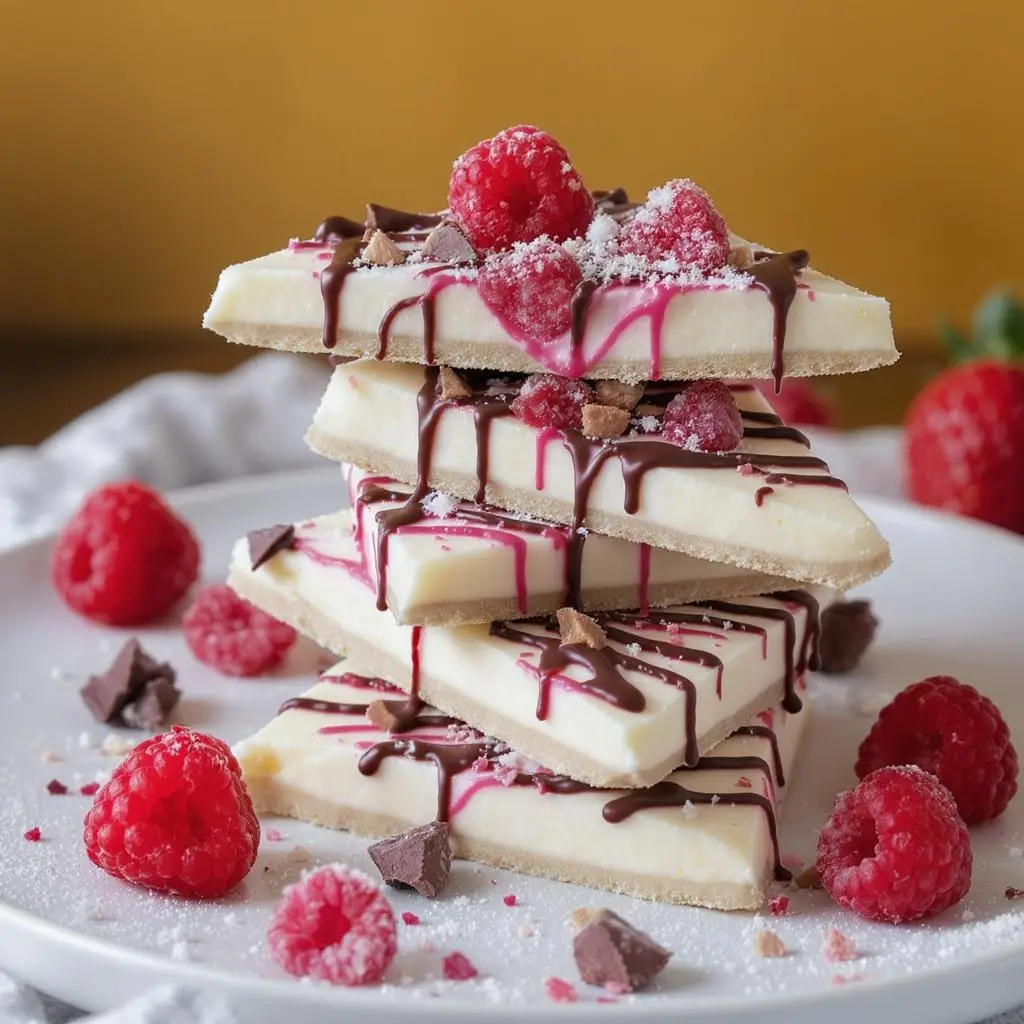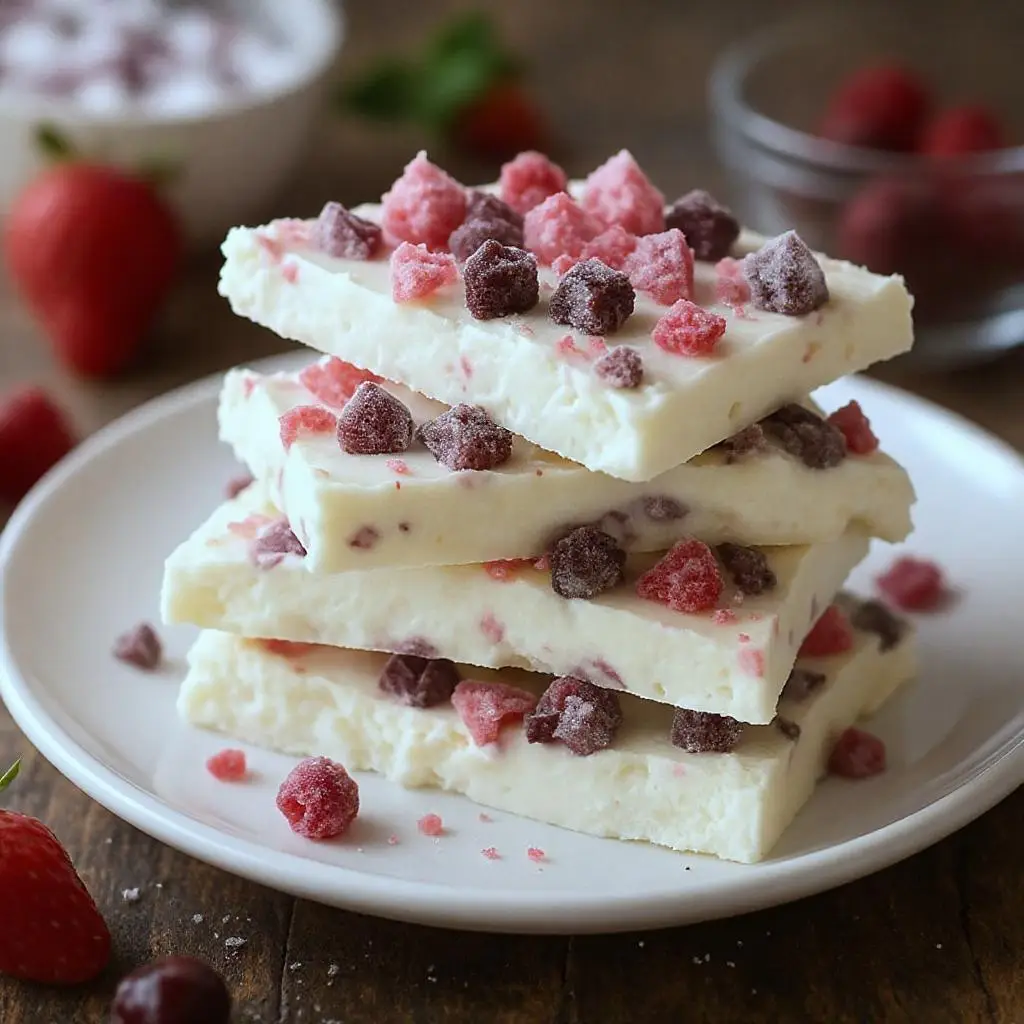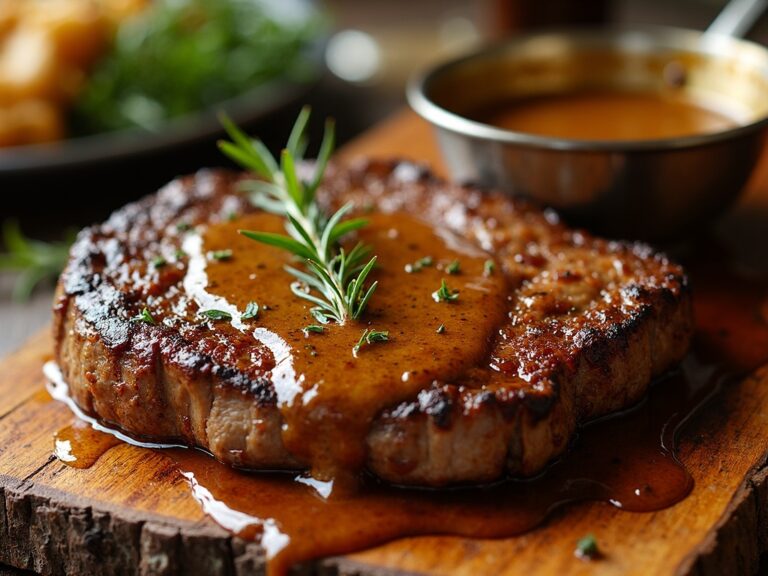I still laugh when I think how my neighbor went on and on about heat shaping flavor even though I am whipping up a frozen treat today. There is something wild about making Frozen Yogurt Bark in a kitchen mostly obsessed with flames and sizzles. I can almost hear him talk about Maillard browning while I spread yogurt on a tray. The contrast is funny but it works because I know every trick he loves, yet I am turning the idea around and using cold to create flavor instead of heat.
This Frozen Yogurt Bark is about simple joy. You take creamy yogurt give it a bit of sweetness swirl in colorful berries and nuts then freeze it flat. The result cracks in your hand much like candy but tastes light enough for a summer afternoon. It feels almost rebellious to write about chilling instead of caramelization right now. But that is the charm.
I admit I worried a bit, because neighbors rarely talk about slow simmer or protein rest when it comes to frosty snacks. But I found that cold and stillness can shape tastes just as much as flame and smoke. Every time I break the edges of my Frozen Yogurt Bark I think about flavor science without any heat at all. It is a small lesson that sometimes cooling down can be just as exciting as turning up the stove.

When I serve a slice of this Frozen Yogurt Bark to friends they get that little crack under their teeth and smile. The hush of the freezer and a quick pop on the tongue can beat any warm dessert every time. I promise you will find magic in the chill without using any flame.
So grab your freezer tray and let us get into the details of how to craft perfect Frozen Yogurt Bark at home even if your neighbor only cares about fire.
Cold Flavor Secrets for Frozen Yogurt Bark
Why does a frozen treat taste so vibrant even with no heat involved in the final steps This goes back to basic food science in the fridge. Cold locks in the tang of yogurt and the bright pop of fruit. It is not about boiling or slow simmer here but about chill retaining charm. When you freeze yogurt you slow down molecular motion so that the natural sugars and proteins each find a spot to rest. This protein rest at cool temps gives that smooth feel in your mouth. You will not see any Maillard browning but you get a sprinkle of caramelization if you add honey or sugar that touched a warm spoon earlier in the prep.
To make a better Frozen Yogurt Bark you want to think about how quick cold and slow freezing create tiny ice crystals instead of giant shards. Set your freezer to a lower setting to speed up the vanish of warmth. Fast chill means smaller ice bits and a silkier texture that feels playful on your tongue. All of that happens without a flame but it uses the same level of precision that cooking low and slow requires on the stove. You end up with a treat that shows how temperature shape taste from heat down to freeze.
Friendly Fridge Stock List for Frozen Yogurt Bark
- Greek yogurt full fat works best for a creamy base
- Honey or maple syrup for a touch of sweetness
- Vanilla extract that little swirl lifts flavor up
- Fresh berries like strawberries or blueberries for color
- Nuts or seeds almonds pecans or chia seeds for a crunchy bite
- Shredded coconut optional fun texture
- Dark chocolate chips freeze well and add a bit of richness
- Nonstick spray or parchment paper to keep it simple
All of these bits come together to make bright Frozen Yogurt Bark that pops in color and taste. You might think about caramelization of fruit sugar if you toss berries with a tiny hint of warm honey first. That adds another layer without any real cooking. It is like a cheat to use heat for one moment then freeze the results. That trick brings out sweet juice and keeps it intact when you freeze your Frozen Yogurt Bark.
Getting Your Tools Ready for Frozen Yogurt Bark
You do not need a blender or a sous vide wand here but a bowl a spatula and a sheet pan or rimmed dish to hold the bark shape. Line your tray with parchment paper then give it a quick spray with oil so the Frozen Yogurt Bark slips off easy later. I use a silicone spatula to spread the yogurt thin. If it is too thick it stays icy in the middle and that is less fun to eat. A small whisk helps you blend in honey or vanilla smoothly. Remember the idea of protein rest applies in reverse here. You want your yogurt as cold as possible before you spread it so it sets fast in the tray.
At this stage you might heat a spoon with a flicker of flame under honey to add a bit of caramelization, then whisk it into the yogurt for a richer note. That bit of warmth melts sugar just enough before it chills down in your dessert. It is a playful nod to how heat shapes flavor even when you end with a frozen treat like Frozen Yogurt Bark.

Picture This Chill Scent Before You Freeze
Close your eyes and imagine a bowl of creamy yogurt with a hint of vanilla in the air. You hear the freezer humming softly as you get everything ready. The berries are bright red and purple, they smell fresh and cold at the same time. You swirl honey through and catch that faint aroma of warmth meeting chill. All these little scents add up to a promise of crisp snap in the finished Frozen Yogurt Bark.
Halfway Freeze Check for Frozen Yogurt Bark
About thirty minutes into freezing it is worth peeking under the parchment. Use a toothpick or the tip of a spoon to prod the center. If it still wiggles like jelly give it more time for a firmer crack later. If it feels nearly solid you are on track. Making Frozen Yogurt Bark is more about timing than any high heat method. You want to coax out ice crystals slowly so the cooling feels even. That bit of low and slow freezing works like a patient stew on the stove but in reverse, it gives you no crunch when it melts too early.
When you get that perfect hold you know the outer bits firmed up around the fruit and nuts. That means each bite will hold berry or almond in place instead of leaving a soggy spot behind. This is all about precision controlling temperature like a chef does with a slow simmer, but here it is in a cold box instead of a pot.
Texture Probe Notes for Frozen Yogurt Bark
The final test comes when you lift the Frozen Yogurt Bark off the tray. It should snap cleanly and not bend. If it bends you need to pop it back in for ten or fifteen more minutes. The crack should be crisp yet not shatter into dust. That is your sweet spot. You will see tiny glints of yogurt crystal around the edges that melt lightly on your tongue.
Notice how the yogurt feels smooth by comparison to an ice cube. That is down to careful freezing, and the idea of protein rest long before you start is part of that. Let your yogurt sit at room temp for five minutes before swirls and pops so that whey separates just a bit. That makes a silkier final bark when it snaps.
Serve It with Color Pop Flair
Break your Frozen Yogurt Bark into shards and arrange them on a platter or plate. You can stack pieces like a fan or let each shard lean against a small bowl of extra fruit. The bright spots of berry color stand out against the white cream. If you have chocolate chips or coconut flakes they add another dash of texture. Serve right away so the bark shows its crisp edges and not soft spots.
Invite friends to pick a shard and let them hear the crack. That little sound is proof of your chill technique and of how cold can shape flavor just like heat. Each bite feels like candy but tastes fresh and light.
Leftover Trick for Frozen Yogurt Bark
If you have leftover Frozen Yogurt Bark bits store them in a freezer safe bag or container. When you need a quick snack you can crush them into yogurt or oatmeal. The shards make a crunchy topping that blends cold with creamy in seconds. It is a fun way to extend your bark into a morning bowl or a smoothie boost. Just pop a handful in your cup and let the cold bits turn your drink into a fancy treat.
Another hack is to mix pieces with granola and fruit in a jar for a layered snack. The ice bits melt enough to give flavor but stay firm long enough to give crunch. That is how cooking techniques translate across recipes from a warm stew to a frozen treat. A simple concept like slow simmer of flavors becomes a gentle freeze of textures for your Frozen Yogurt Bark.
Your Final Scoop and Faqs for Frozen Yogurt Bark
By now you have seen how a freezer can be as mighty as a burner when it comes to shaping taste. Frozen Yogurt Bark is an easy crowd pleaser that highlights how cold holds flavor in place. It is a great intro to temperature techniques with no grill or hot pan required. Let us answer a few questions you might still have.
Faq What yogurt works best for Frozen Yogurt Bark
Full fat Greek yogurt or strained yogurt both give a rich creamy texture. Low fat yogurt can make it icy and less smooth so opt for a thicker style when possible.
Faq Can I use non dairy yogurt for Frozen Yogurt Bark
Yes you can try coconut yogurt or almond yogurt. The texture might vary so give it a quick protein rest at room temp before freezing to smooth it out.
Faq How long does Frozen Yogurt Bark stay good
It holds its best crisp texture for about two weeks in a well sealed bag. After that it may frost over and lose that nice snap.
Enjoy exploring more ways to blend chill with flavor science. From caramelization of sugar under a spoon to the low and slow chill in your freezer you now have a new treat in your rotation. Serve fresh Frozen Yogurt Bark or remix it as a topping you will see that good flavor can come from cooling as much as from heat.

Frozen Yogurt Bark
Ingredients
Equipment
Method
- Line a baking tray with parchment paper, letting the edges hang over for easy removal later.
- In a mixing bowl, combine the Greek yogurt, honey, and vanilla extract. Stir until smooth and well-blended.
- Pour the yogurt mixture onto the prepared tray, using a spatula to spread it evenly into roughly a 1/4-inch thick rectangle.
- Evenly scatter the strawberries, blueberries, almonds, and chocolate chips over the yogurt layer.
- Gently press the toppings into the yogurt so they adhere better once frozen.
- Place the tray flat in your freezer and freeze for at least 2 hours, or until the yogurt is completely firm.
- Once set, remove from the freezer. Lift the bark out using the parchment paper, transfer to a cutting board, and slice or break into 6 pieces.
- Serve immediately, or store leftovers in an airtight container in the freezer.





